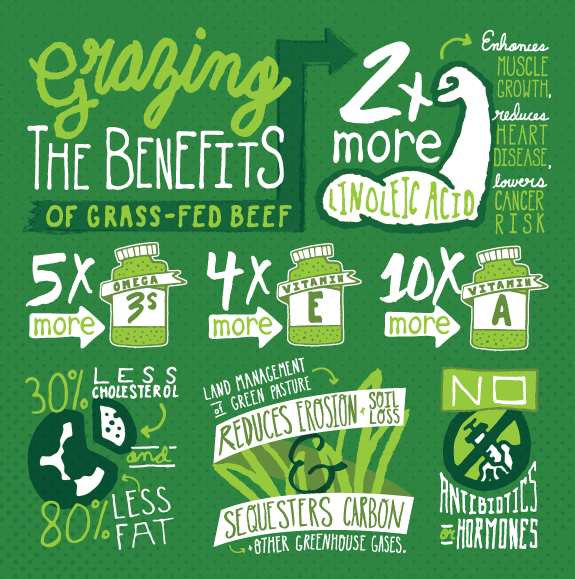Understanding Grassfed

Check out this Times Union Article, featuring our Meat & Seafood Manager, Mo, from January 4th, 2018: Area farms carve grass-fed, pasture-raised meat niche and read the information from our "Go Grassfed" pamplet, below!
What do grass-fed and grass-finished mean?
Grass-fed beef comes from cattle that have spent their entire lives on pasture, eating grasses and other non-woody plants. Whereas most cattle spend their last days fattening up on a concentrated mix of corn, soy, grains, and other supplements, plus hormones and antibiotics in a feedlot, grass-finished cattle are never fed grain and are allowed to mature to their “finished” size while solely eating plants.
Despite an increase in consumer demand for grass-fed beef in the U.S., the market for grass-fed is possibly less than 3% of all beef sales. But we can vote with our dollars and create more of a market for grass-fed by supporting small, local farms!

Why do we prefer grass-fed beef?
It has lower levels of fat and calories in general, and specifically smaller amounts of unhealthy fats. Meanwhile, it boasts 2 to 4 times more healthy omega-3 fatty acids than grain-fed beef, has lower levels of dietary cholesterol, and provides more beta-carotene, antioxidants, and vitamins B, A, and E. It also offers more calcium, magnesium, and potassium, and nearly twice as much healthy conjugated linoleic acid (CLA), which can help lower the risk of diabetes and may have cancer fighting properties.
And it’s better for the planet: Whereas cattle raised on feedlots emit massive amounts of greenhouse gases, well-maintained pasture actually draws such gasses out of the air and stores them in living plant matter. Pasturelands reduce erosion and soil loss, increase the number of native plants, reduce the use of petrochemicals, and restore natural ecosystems.
Cooking Grassfed Beef
Tips To Consider:
- Grass-fed beef is more lean, so it cooks 30% faster than conventional. To avoid overcooking, use a meat thermometer, and remove from the oven when it’s between 120 (very rare) and 140 (medium rare) degrees,
- Marinate! It increases the moisture content of meat, and adds a flavor element that really enhances lean cuts like sirloins and NY strips.
- Before preparing, be sure to let beef come to room temperature on the counter, which takes about 20 minutes. Never cook it straight from the fridge.
- Preheat your oven, grill, or pan thoroughly first, to make sure you get a good sear.
- No forks allowed – use tongs to flip or move steaks. Tiny fork holes will let juices escape!
- Patience – let your meat rest after cooking for 8-10 minutes before you eat it. This ensures good flavor distribution and juiciness.
